The Loudspeaker CookBook from Vance Dickason has documented chapters about the subject :
- damping material quality, quantity and placement.
- port position, size and number.
I don't know if you have this book @JRiv and @Guerilla, but if not : buy it ! it is worth every penny... So are those of Martin Colloms (High Performance Loudspeakers) and Joseph d'Appolito (Testing Loudspeakers).
Hi @tubelectron, I've found few editions of the "The loudspeaker design cookbook" from Vance Dickason, the "Fifth Edition" from year 1995 and the "New Expanded Sixth Edition" from year 2000, could you share the exact edition/year of the book you have, I would like to buy that specific version and read more about the insulation amount/density and port placements.
Forgot to post the images of the bookshelf port inner view so here are few, I'm also a fan of the front ported boxes and mostly with ports placed in the front low, but made an exception with a down firing design like I did on my 21" Down-Firing Port Subwoofers.
Between due space constraint in the bookshelf I have to place the port in the back of the little boxes in between the tweeter and the woofer, I could place it a little higher to get away from the midbass but the horn and the compression driver could be an issue due they too close proximity.

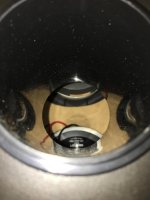
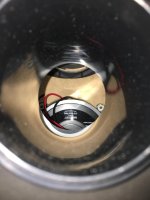
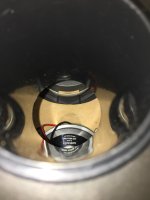
Regards
@JRiv : my edition is French, from 1996 - and is full of re-typing and translation mistakes that I had to correct and annotate, ma parole, j'y crois pas  ! - So that I plan to buy the English language one... So I think that the matching edition in English should be the 1995 one you mention.
! - So that I plan to buy the English language one... So I think that the matching edition in English should be the 1995 one you mention.
Vance Dickason about back-sided ports wrote IIRC : "maybe it will slightly decrease bass response in axis if the port output is too close from the wall". He made several position configurations but did not came to a general undisputable rule of placement.
A friend of mine made heavy cut and try tests on a project similar to my 375L vintage Monitor in size, and determined that the best placement of the port was at the back at 1/3 of the height for this project, but on another one, a bookshelf similar to my 222L, the best placement proved to be in front... It seems that it is a case-by-case basis.
When my acoustic measurement rig was still valid, I experimented rather center-placed port formulas, in order to "pick" the sound pressure belly (= speed acousic air displacement), conversely to the faces, where only node pressure can occur ( notably responsible of the panel vibrations). But this idea proved rule-inconclusive, or again a case-by-case basis !
T
Vance Dickason about back-sided ports wrote IIRC : "maybe it will slightly decrease bass response in axis if the port output is too close from the wall". He made several position configurations but did not came to a general undisputable rule of placement.
A friend of mine made heavy cut and try tests on a project similar to my 375L vintage Monitor in size, and determined that the best placement of the port was at the back at 1/3 of the height for this project, but on another one, a bookshelf similar to my 222L, the best placement proved to be in front... It seems that it is a case-by-case basis.
When my acoustic measurement rig was still valid, I experimented rather center-placed port formulas, in order to "pick" the sound pressure belly (= speed acousic air displacement), conversely to the faces, where only node pressure can occur ( notably responsible of the panel vibrations). But this idea proved rule-inconclusive, or again a case-by-case basis !
T
Hi, just a small update in regards the crossover in this old little project.
I just decided to tweak the crossover a bit to make it a little flatter response in the middle frequencies but without modifying the low-pass xover to avoid introducing mids distortion at high power levels due early cone breakup etc.
Then since the compression driver is the least stressed/driven part in this speakers I've opted to lower the HF crossover point just a tad, so just changed the 0.35mH inductor for a 0.5mH, and changed the 2.7uF capacitor for a 3.3uF and they opened up nicely, here below is the info for reference.
Here is the simple crossover mod:
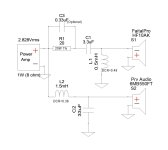
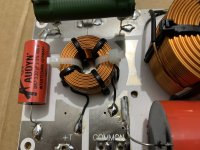
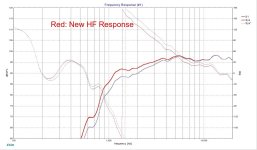
Here is the bookshelf response with the mic on-axis at tweeter/horn level and in between both drivers:
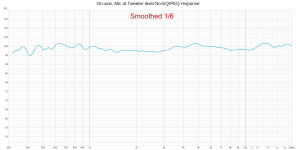
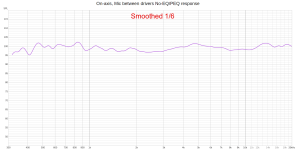
Between with just a little EQ/PEQ from the DSP this little speakers can be flatten from ~250Hz up but wanted to show just the raw response, also sorry I can't provide measurements of the lower frequencies since my room is too anemic and contaminates the measurements with tons of peaks/valleys reflections.
Regards
I just decided to tweak the crossover a bit to make it a little flatter response in the middle frequencies but without modifying the low-pass xover to avoid introducing mids distortion at high power levels due early cone breakup etc.
Then since the compression driver is the least stressed/driven part in this speakers I've opted to lower the HF crossover point just a tad, so just changed the 0.35mH inductor for a 0.5mH, and changed the 2.7uF capacitor for a 3.3uF and they opened up nicely, here below is the info for reference.
Here is the simple crossover mod:



Here is the bookshelf response with the mic on-axis at tweeter/horn level and in between both drivers:


Between with just a little EQ/PEQ from the DSP this little speakers can be flatten from ~250Hz up but wanted to show just the raw response, also sorry I can't provide measurements of the lower frequencies since my room is too anemic and contaminates the measurements with tons of peaks/valleys reflections.
Regards
Imagine painting them in an unusual paint called Vanta Black. It's a nanotube-containing paint that absorbs over 99% of light that strikes it, so an object painted with that has the appearance of a black hole. It's a void!Bookshelf boxes build images continuation:
View attachment 1205171 View attachment 1205172 View attachment 1205173 View attachment 1205174 View attachment 1205175 View attachment 1205176 View attachment 1205177
Hi @egellings I've always used standard Black-Matte laminate as it is cheap plus so much easier(subjectively) to work with and I always think it will also provides an extra layer of box protection as well, unfortunately I was never good at painting and I admit Piano-Black is my finish of preference.
Regards!
Regards!